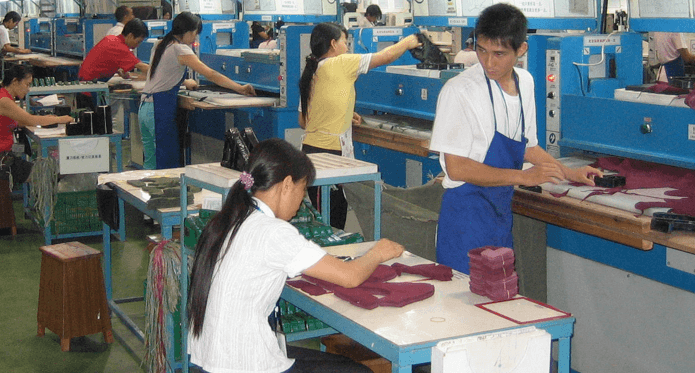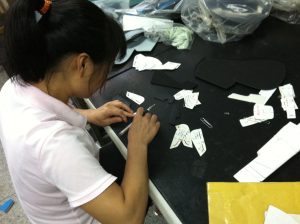How long does it take to make a pair of shoes?
Production Timing
How long does it take to make a pair of shoes? The answer is… it depends. An efficient shoe factory sample room can make a pair of shoes in one day. It is easy to cut, stitch, and last a pattern in just a few hours. However, if you don’t have the materials on hand, or need printed logos, welded details, or hardware, it’s a totally different story.
A new development sample that requires a new shoe pattern and outsole tooling can take 4-6 weeks to process. This amount of time should be sufficient for a pair of shoes in the correct color, material, and molded outsole. Keep in mind, a fashion shoe that does not require an outsole can be made much faster.
How long does it take a shoe factory to make a production order?
So, let’s talk about how long it takes a shoe factory to make a production order of 5000 pairs. Let’s assume the development process is complete: the upper patterns for every shoe size are confirmed, the cutting dies have been checked, and the outsole tooling for every size is approved.The answer depends on how busy the factory is, but basically you’re looking at about 60 days from when the order is placed to when the shoe can be packed for delivery. This can easily stretch out to 90 days if the factory is totally booked. 120 days is getting really late.
Why does it take so long?
The challenge of modern mass production shoemaking is really about organization and logistics. The process of putting a shoe together is not difficult. The process of getting all the shoe parts together at the same time, in the same room, ready for assembly, is the time-consuming challenge!Shoe Materials
With a new shoe order in hand, the first thing the factory will do is to calculate the material required to produce the quantity. The factory will then order the material from the vendors and component subcontractors. Factories do not stock raw materials for shoes, they have to wait until they receive an order to buy the materials. The shoe material makes up about 50% of the final cost. The factory will have to use a line of credit borrowed against the shoe order to buy the materials. Because of this, a shoe factory may demand a 50% payment up front when the order is placed. This process can take a week to complete. The shoe material purchasing process can be complicated. Some shoe material vendors may demand cash up front, and some may have capacity issues. Negotiating the purchase terms with a new vendor can cause delays. Also, there may be material color or quality issues that require the material to be remade…more lost time.Material Timing
Some parts or materials take longer than others. Whether it’s shoelaces, leather, or mesh rubber components, all these materials have different lead times. While the factory may order all these components in one day, it may take two weeks to produce the outsoles, three weeks for the mesh, and four weeks for the leather to arrive. Timing also depends on sub-component processing. In the case of outsoles or midsoles, the factory must consider the productivity of the molds. If you only have one size 9 EVA mold, and assuming it could take 20 minutes to make one piece from that mold, the factory may only be able to make 30 pieces in one day. In this situation, you may need to buy more molds in order to make production faster for popular sizes.Processing Materials
It may take 30 to 40 days for the materials to be delivered to the shoe factory. Once the material arrives it will have to be processed before stitching can begin. Some shoe material may need to be cut and sent out for logo embroidery. Other materials may need to be sent over to the shoe factory’s in-house welding or screen printing departments. This pre-processing of the materials takes time. The shoe factory cannot start stitching the shoes until all of the components are inside the factory. If the shoelaces are missing, or there’s no shoebox or outsole, the factory cannot start the assembly process.
The outsole unit may have to be made in a separate factory. There may be one factory that presses the rubber and another factory that presses the midsole. These two pieces will come together in the shoe factory stock fitting department. The stock fitting line will glue the parts together and maybe add a logo before the shoe sole is ready to meet with the upper on the assembly line.
Shoe Assembly
One stitching line can stitch about 800 pieces in one day depending on the complexity of the stitching operations. One shoe assembly line can usually assemble 1200 to 1500 pairs in one day. So, two shoe stitching lines are required to support one shoe assembly line, and a five line factory can complete approximately 5000 to 8000 pairs of shoes per day.
Production Timing
How long does it take to make a pair of shoes? The answer is… it depends. An efficient shoe factory sample room can make a pair of shoes in one day. It is easy to cut, stitch, and last a pattern in just a few hours. However, if you don’t have the materials on hand, or need printed logos, welded details, or hardware, it’s a totally different story.
A new development sample that requires a new shoe pattern and outsole tooling can take 4-6 weeks to process. This amount of time should be sufficient for a pair of shoes in the correct color, material, and molded outsole. Keep in mind, a fashion shoe that does not require an outsole can be made much faster.
How long does it take a shoe factory to make a production order?
So, let’s talk about how long it takes a shoe factory to make a production order of 5000 pairs. Let’s assume the development process is complete: the upper patterns for every shoe size are confirmed, the cutting dies have been checked, and the outsole tooling for every size is approved.The answer depends on how busy the factory is, but basically you’re looking at about 60 days from when the order is placed to when the shoe can be packed for delivery. This can easily stretch out to 90 days if the factory is totally booked. 120 days is getting really late.
Why does it take so long?
The challenge of modern mass production shoemaking is really about organization and logistics. The process of putting a shoe together is not difficult. The process of getting all the shoe parts together at the same time, in the same room, ready for assembly, is the time-consuming challenge!Shoe Materials
With a new shoe order in hand, the first thing the factory will do is to calculate the material required to produce the quantity. The factory will then order the material from the vendors and component subcontractors. Factories do not stock raw materials for shoes, they have to wait until they receive an order to buy the materials. The shoe material makes up about 50% of the final cost. The factory will have to use a line of credit borrowed against the shoe order to buy the materials. Because of this, a shoe factory may demand a 50% payment up front when the order is placed. This process can take a week to complete. The shoe material purchasing process can be complicated. Some shoe material vendors may demand cash up front, and some may have capacity issues. Negotiating the purchase terms with a new vendor can cause delays. Also, there may be material color or quality issues that require the material to be remade…more lost time.Material Timing
Some parts or materials take longer than others. Whether it’s shoelaces, leather, or mesh rubber components, all these materials have different lead times. While the factory may order all these components in one day, it may take two weeks to produce the outsoles, three weeks for the mesh, and four weeks for the leather to arrive. Timing also depends on sub-component processing. In the case of outsoles or midsoles, the factory must consider the productivity of the molds. If you only have one size 9 EVA mold, and assuming it could take 20 minutes to make one piece from that mold, the factory may only be able to make 30 pieces in one day. In this situation, you may need to buy more molds in order to make production faster for popular sizes.Processing Materials
It may take 30 to 40 days for the materials to be delivered to the shoe factory. Once the material arrives it will have to be processed before stitching can begin. Some shoe material may need to be cut and sent out for logo embroidery. Other materials may need to be sent over to the shoe factory’s in-house welding or screen printing departments. This pre-processing of the materials takes time. The shoe factory cannot start stitching the shoes until all of the components are inside the factory. If the shoelaces are missing, or there’s no shoebox or outsole, the factory cannot start the assembly process.
The outsole unit may have to be made in a separate factory. There may be one factory that presses the rubber and another factory that presses the midsole. These two pieces will come together in the shoe factory stock fitting department. The stock fitting line will glue the parts together and maybe add a logo before the shoe sole is ready to meet with the upper on the assembly line.
Shoe Assembly
One stitching line can stitch about 800 pieces in one day depending on the complexity of the stitching operations. One shoe assembly line can usually assemble 1200 to 1500 pairs in one day. So, two shoe stitching lines are required to support one shoe assembly line, and a five line factory can complete approximately 5000 to 8000 pairs of shoes per day.


